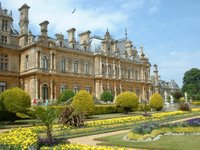
For a variety of reasons I have not been very active with my camera for some while now so I am taking this opportunity to recall a visit a couple of years ago to Waddesdon Manor, another National Trust property, this time in Buckinghamshire , close to Aylesbury.
The magnificent exterior provides the perfect setting for one of the best collections of French 18th century decorative arts in the world, paintings, furniture, carpets and curiosities, lovingly assembled over 35 years by Ferdinand to please his weekend guests.

The grounds are extensive and were largely the creation of the Rothschild family who still have an active interest in the property. There are seasonal changes made to the displays, some of which are a bit reminiscent of British public parks planting, but non the less impressive for that.

One of the most unusual features of the garden is the Aviary. Completed in 1889 by an unknown architect, it was built for Baron Ferdinand as a reminder of one he had grown up with in his childhood home, the Villa Grüneburg outside Frankfurt. It is made of cast-iron in the style of a rococo trelliswork pavilion, such as those erected at Versailles and Chantilly in the early eighteenth-century.

Beyond the parterre garden to the south of the house is an ornamental pond which is very reminiscent, I thought, to Versailles in France.
All in all, a good day out, with a chance at the end to stock up on some of the famous (but pricey) Rothschild wines.
Take a look also at
National Trust | Waddesdon Manor for further information.
I have more pictures at
Smugmug : Waddesdon Manor

 The grounds are extensive and were largely the creation of the Rothschild family who still have an active interest in the property. There are seasonal changes made to the displays, some of which are a bit reminiscent of British public parks planting, but non the less impressive for that.
The grounds are extensive and were largely the creation of the Rothschild family who still have an active interest in the property. There are seasonal changes made to the displays, some of which are a bit reminiscent of British public parks planting, but non the less impressive for that.
